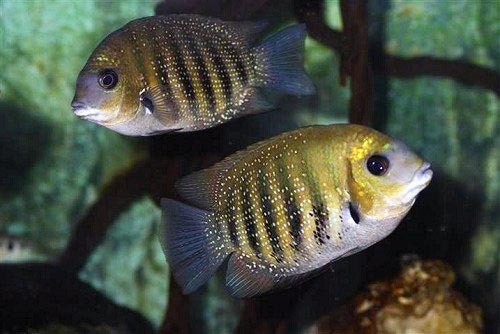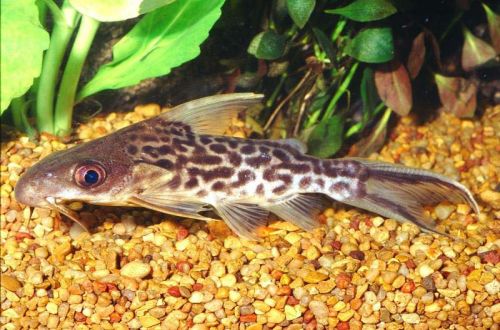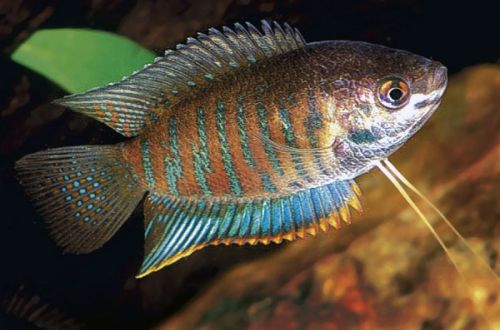
Green Chromide
Etroplus striped or Green Chromide, scientific name Etroplus suratensis, belongs to the Cichlidae family. Due to its size and not very expressive coloring, this species is not widely used in the aquarist. However, it has a certain interest due to its ability to live in fresh and brackish (almost sea) water.

Contents
Habitat
The homeland of this species is the island of Sri Lanka. Since the 1950s, it has been introduced to the continent for the purpose of breeding for the aquarium hobby, since then wild populations are widely found in the southern states of India, Bangladesh, as well as in peninsular Malaysia and Singapore.
It lives in the lower reaches of rivers, brackish estuaries (from Latin aestuarium – a flooded mouth of the river), coastal lagoons. This species belongs to euryhaline, able to live in a wide range of water salinity, as well as in freshwater reservoirs.
Brief information:
- The volume of the aquarium – from 500 liters.
- Temperature – 20-30°C
- Value pH — 7.0–9.5
- Water hardness – medium to high hardness (10-21 dGH)
- Substrate type – sandy
- Lighting – subdued
- Brackish water – yes, the permissible concentration is up to 15 g. of salt per liter
- Water movement is weak
- The size of the fish is 25–35 cm.
- Nutrition – meat feed with vegetable additives
- Temperament – peaceful
- Content in a group of at least 8 individuals
Description

Adult individuals reach a length of up to 25–35 cm. The fish has a high oval-shaped body, laterally compressed, resembling an elongated disk. The dorsal and anal fins are low, but extend from head to tail. The coloration is greenish with dark diagonal stripes of the same shade and numerous small specks that dot the entire body. In general, the coloration is rather dull in comparison with the closest relative Orange Chromid, especially with its breeding forms. Sexual dimorphism is weakly expressed, it is problematic for an inexperienced aquarist to distinguish a male from a female.
Food
In nature, they feed on small crustaceans, insect larvae, worms, mollusks, as well as algae and aquatic plants. In a home aquarium, it is desirable to serve similar foods, such as live or frozen bloodworms, brine shrimp, and spirulina flakes. An excellent alternative would be to use dry food in the form of flakes and/or pellets with a high content of protein and herbal supplements.
Behavior and Compatibility
Green Chromide can be called a conditionally peaceful fish, it gets along well with other non-aggressive species, however, during the spawning period, the behavior becomes unpredictable, in case of a lack of free space, it will attack smaller neighbors in the aquarium, protecting its territory.
Intraspecific relationships are built on the dominance of adults and large fish. It is recommended to keep at least 8 individuals in a group, with a smaller number it is likely that the weakest individual will be shaded by relatives. Therefore, the more of them, the more comfortable they feel.
Maintenance and care, arrangement of the aquarium
To keep a group of such large fish, you will need a large aquarium of at least 500 liters. The design is optional at the discretion of the aquarist. Typically, a sandy substrate with a mound of stones, live or artificial plants, and a few snags are used.
Water conditions can be both fresh and brackish with a salt concentration of up to 15 grams per liter. The main difficulty in maintenance is the need to maintain high water quality. In addition to a productive filtration system, a weekly replacement of 25–50% of the volume of water with fresh water will be required. The latter in a large aquarium is not an easy task, unless a system for adding water directly from the water supply is provided (of course, with preliminary cleaning).
Breeding / breeding
The stimulus for the start of spawning is a gradual increase in temperature and salinity, which mimics the beginning of the dry season in their natural habitat. With the onset of the mating season, several fish from the group form a temporary pair, which lasts for quite a long time. Parents take care of the laying and protect it (and then the fry) from other neighbors in the aquarium. Eggs are attached to a stone or plant with thin threads to prevent their accidental movement. The incubation period lasts 2 days at a temperature of 27°C, after another 3-4 days the fry begin to swim freely, but continue to stay close to the female.
In the general aquarium, the survival rate of fry is at a very low level. There are several reasons for this: in a large volume of water it is difficult to provide adequate nutrition, young inexperienced Orange Chromids often eat their own eggs, in addition, fry often fall prey to other fish, even despite the protection of their parents. You can save the offspring in a separate tank with identical water conditions, if you place an element of decor (stones, plants) there, on which the eggs are attached. Parents do not need to be relocated.
Fish diseases
The main cause of most diseases is unsuitable living conditions and poor-quality food. If the first symptoms are detected, you should check the water parameters and the presence of high concentrations of hazardous substances (ammonia, nitrites, nitrates, etc.), if necessary, bring the indicators back to normal and only then proceed with treatment. Read more about symptoms and treatments in the Aquarium Fish Diseases section.





